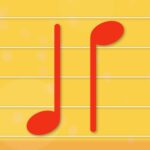Build Your Skills
Learn music theory Train your ears Track your tempoRead Now
Get the Newsletter
Categories
- | BeatMirror (10)
- | HearEQ (11)
- | Waay (22)
- | WaayFinder (1)
- Audio (16)
- For musicians (34)
- Guitar (2)
- Music theory (15)
- News (42)
- Startup stories (2)
- Tutorial (4)
Keep in Touch
About Ten Kettles
We love music, we love learning, and we love building brand new things. We are Ten Kettles.
Read more >-
May 19, 2015
What’s the frequency of C, and why should you care?
Answer: 261.6 Hz.
Why would we ever need to know the frequency of notes? Well, there could be a few different reasons, but one has to do with mixing audio. When equalizing (EQing) an audio track, one common challenge is filtering out background noise—especially if the track was recorded with a microphone. Here’s what the mic might be picking up:
- The rumble of a streetcar or truck going by in the distance
- An accidental knock of the microphone stand
- A door closing somewhere in your building
Your best route to eliminating background noise is to cut it out at the source… but in many cases (barring time travel) that’s just not possible. So, we use an equalizer, or EQ, to lend a helping hand.
Take a guitar track, for example. What’s the lowest sound you’d expect to come from a guitar? If it’s in standard tuning, the lowest string is tuned to E2, which has a frequency of 82.4 Hz (see the table below). This means that any sound below ~80 Hz is not guitar. So, if we filter out everything below that frequency, we cut out the low noise (like the streetcar rumble) but keep all that wonderful guitar sound. Not bad! The name for this kind of filter is a high-pass filter, because it lets all the high frequencies pass—and keeps out the low ones.
Below is a table of all the note frequencies, with the highest and lowest notes of various instruments highlighted. The first column is the octave number; for example, the low E string on a guitar is tuned to E2—that’s E in the 2nd octave.
Note Freq. (Hz) Instrument 0 C 16.35 C♯/D♭ 17.32 D 18.35 D♯/E♭ 19.45 E 20.60 Approximate lower limit of human hearing
(increases with age)F 21.83 F♯/G♭ 23.12 G 24.50 G♯/A♭ 25.96 A 27.50 A♯/B♭ 29.14 B 30.87 Lowest note of a 5-string bass 1 C 32.70 C♯/D♭ 34.65 D 36.71 D♯/E♭ 38.89 E 41.20 Lowest note of a 4-string bass F 43.65 F♯/G♭ 46.25 G 49.00 G♯/A♭ 51.91 A 55.00 A♯/B♭ 58.27 B 61.74 2 C 65.41 C♯/D♭ 69.30 D 73.42 D♯/E♭ 77.78 E 82.41 Lowest note of a guitar F 87.31 F♯/G♭ 92.50 G 98.00 Approximate low-end of male vocals
(depends greatly on individual)G♯/A♭ 103.8 A 110.0 A♯/B♭ 116.5 B 123.5 3 C 130.8 C♯/D♭ 138.6 D 146.8 D♯/E♭ 155.6 E 164.8 F 174.6 F♯/G♭ 185.0 G 196.0 Approximate low-end of female vocals
(depends greatly on individual)G♯/A♭ 207.7 A 220.0 A♯/B♭ 233.1 B 246.9 4 C 261.6 (Middle C) C♯/D♭ 277.2 D 293.7 D♯/E♭ 311.1 Highest note of a 4 or 5-string bass E 329.6 F 349.2 F♯/G♭ 370.0 G 392.0 Approximate high-end of male vocals
(depends greatly on individual)G♯/A♭ 415.3 A 440.0 A♯/B♭ 466.2 B 493.9 5 C 523.3 C♯/D♭ 554.4 D 587.3 D♯/E♭ 622.3 E 659.3 F 698.5 F♯/G♭ 740.0 G 784.0 Approximate high-end of female vocals
(depends greatly on individual)G♯/A♭ 830.6 A 880.0 A♯/B♭ 932.3 B 987.8 6 C 1047 Highest note of a 20-fret guitar C♯/D♭ 1109 D 1175 D♯/E♭ 1245 E 1319 F 1397 F♯/G♭ 1480 G 1568 G♯/A♭ 1661 A 1760 A♯/B♭ 1865 B 1976 7 C 2093 C♯/D♭ 2217 D 2349 D♯/E♭ 2489 E 2637 F 2794 F♯/G♭ 2960 G 3136 G♯/A♭ 3322 A 3520 A♯/B♭ 3729 B 3951 8 C 4186 C♯/D♭ 4435 D 4699 D♯/E♭ 4978 E 5274 F 5588 F♯/G♭ 5920 G 6272 G♯/A♭ 6645 A 7040 A♯/B♭ 7459 B 7902 9 C 8372 C♯/D♭ 8870 D 9397 D♯/E♭ 9956 E 10,548 F 11,175 F♯/G♭ 11,840 G 12,544 G♯/A♭ 13,290 A 14,080 A♯/B♭ 14,917 B 15,804 10 C 16,744 C♯/D♭ 17,740 D 18,795 D♯/E♭ 19,912 Approximate upper limit of human hearing
(decreases with age)E 21,096 F 22,351 F♯/G♭ 23,680 G 25,088 G♯/A♭ 26,580 A 28,160 A♯/B♭ 29,834 B 31,609 NOTE: The frequency values above use the standard A4=440 Hz tuning system.
If you’re looking for some ear training to boost your mixing skills (and want to hear some cool EQing examples), check out our hearEQ video. You can also read up on audio and EQing with our Audio Primer (lots of audio samples), check out our tutorial on EQing an audio track, and even follow along as we EQ a podcast. Questions, comments, or want to see more instruments on our note frequency chart? Send us a note or feel free to leave a comment.



Just read your post here. I have a question for you. Do you have a particular type of guitar tuner you prefer? I’m deciding whether I want to get a clip on tuner or on the of plugin kind. I’d be using it on my acoustic, but the guitar has a pickup too. I appreciate the help.
Hey Dario, thanks for the comment. Personally, I love my Boss Chromatic Tuner (TU-2). For acoustic I’ll often plug into that directly, but I do have an old Seiko one that sits on my music stand in case I don’t have a patch handy. Hope that helps! -Alex